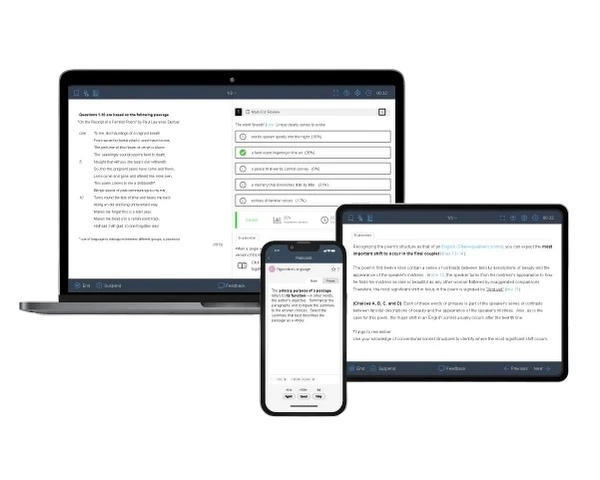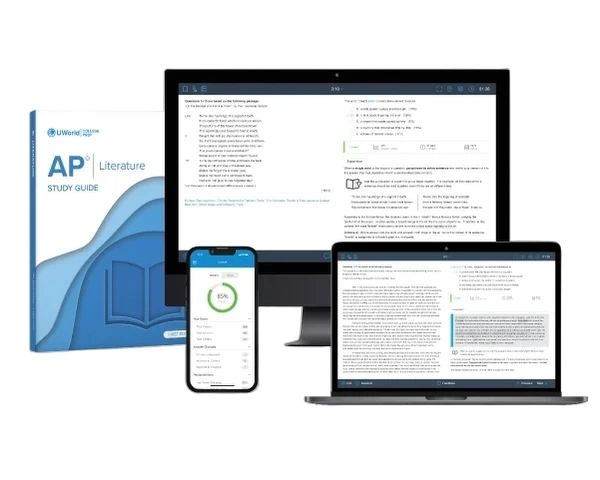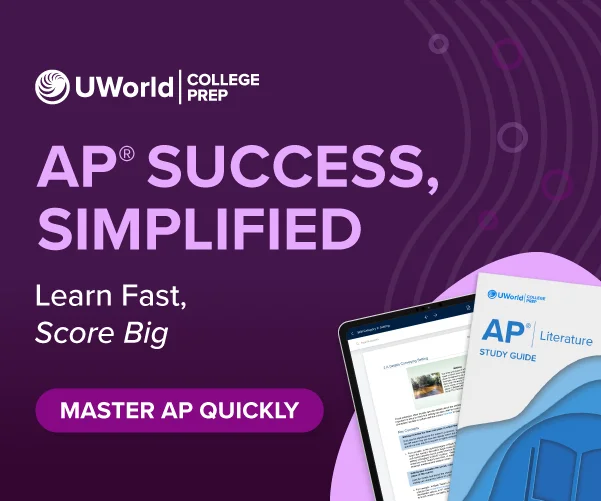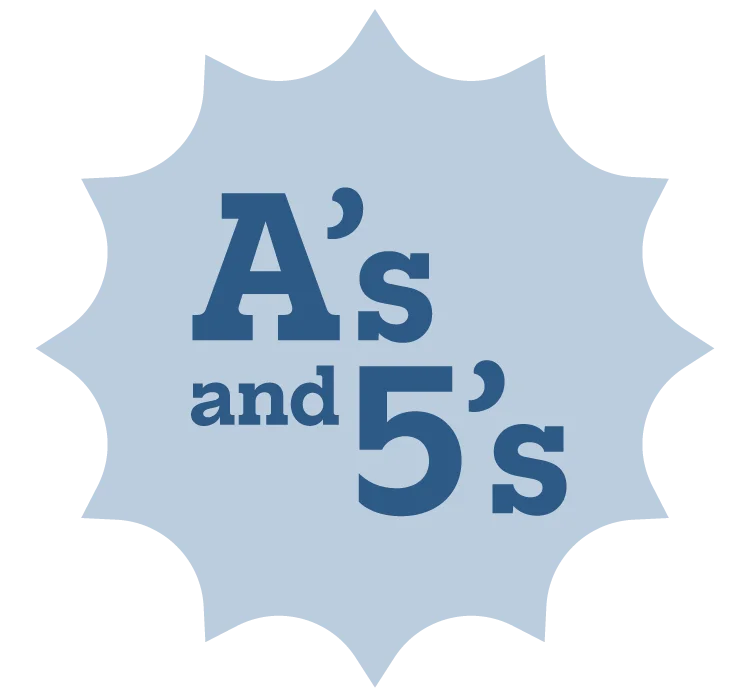The AP® English Literature and Composition course framework comprises 2 primary components as prescribed by the College Board®: Big Ideas and Enduring Understandings and Course Skills. Big ideas provide long-term takeaways, while course skills include understanding, analyzing, and interpreting texts, as well as constructing claims in argumentative essays.
AP Lit units explore different aspects of these big ideas through the lens of specific texts and literary devices. To enhance your preparation for the AP Lit course and exam, use our AP English Literature Online Prep Course, which provides tailored practice and expert guidance to help you master these components.
6 Big Ideas and Enduring Understandings
The big ideas form the backbone of the AP Lit concepts, connecting AP English Literature and Composition units. These include:
-
Big Idea 1: CHARACTER (CHR)
Enduring Understanding CHR-1
In narrative literature and poetry, characters reflect a wide range of traits, motives, actions, dialogues, values, and cultural conventions.
-
Big Idea 2: SETTING (SET)
Enduring Understanding SET-1
A setting defines the time and place of a narrative and plays a role in plot development and meaning.
-
Big Idea 3: STRUCTURE (STR)
Enduring Understanding STR-1
Narrative structure shapes the reader's understanding of a text.
-
Big Idea 4: NARRATION (NAR)
Enduring Understanding NAR-1
The narrator's perspective influences how readers experience a text.
-
Big Idea 5: FIGURATIVE LANGUAGE (FIG)
Enduring Understanding FIG-1
Rhetorical devices and word choices impact a text’s meaning.
-
Big Idea 6: LITERARY ARGUMENTATION (LAN)
Enduring Understanding LAN-1
Analyze literature to develop and defend a claim effectively.
Practicing with AP English Literature Practice Tests will ensure you're familiar with how these big ideas apply to exam prompts.
AP English Literature Course Skills
In addition to the big ideas and enduring understandings, the AP English Literature and Composition course helps you develop specific skills and abilities. These course skills are the basis of the tasks on the AP English Literature exam.
Explore these skills further in our comprehensive AP English Literature Study Guide, available in print and digital format to reinforce your learning and improve your performance.
Every prompt on the exam will require you to use 1 or more of these course skills to answer them successfully. The College Board has listed 7 course skills for the AP Lit exam. These are:
-
Skill Category 1
Characters play a vital role in shaping a narrative. Their beliefs, values, biases, ideologies, and actions are crucial to understanding and interpreting a literary work. This skill category focuses on analyzing characters’ perspectives, intentions, and functions within a text.
-
Skill Category 2
This skill helps you analyze the setting of a text, including its specific details and their significance. You will also explore the connection between characters and their environment and how these elements influence the narrative.
-
Skill Category 3
Here, you’ll analyze the function of plot and structure in a text. This includes identifying the sequence of events, whether linear or non-linear, and understanding how the narrative's structure influences its meaning and purpose.
-
Skill Category 4
This skill focuses on understanding the role of the narrator or speaker in a text. You’ll examine their position, perspective, belief systems, and biases to interpret how the narrative unfolds and impacts the reader.
-
Skill Category 5
This category emphasizes analyzing word choice, imagery, and symbolism in a text. You’ll learn to distinguish between literal and figurative meanings and interpret the significance of figurative language, such as metaphors, symbols, and imagery.
-
Skill Category 6
This skill focuses on identifying and interpreting comparisons in literature, such as metaphors, similes, and personification. You’ll analyze how these comparisons define characters, settings, or narratives and contribute to the text’s overall meaning.
-
Skill Category 7
The final skill teaches you to develop well-supported arguments in response to a prompt. You’ll learn to create a thesis, defend it with textual evidence, and maintain a logical line of reasoning throughout your analysis.

9 AP Lit Units
The course content consists of 9 units, divided into Short Fiction, Poetry, and Longer Fiction or Drama. Each unit builds your knowledge and skills, preparing you to succeed on the exam.
| Units | Exam Weight | Class Periods |
|---|---|---|
| Unit 1: Short Fiction I | 42-49% | 10 |
| Unit 4: Short Fiction II | 17 | |
| Unit 7: Short Fiction III | 17 | |
| Unit 2: Poetry I | 36-45% | 10 |
| Unit 5: Poetry II | 17 | |
| Unit 8: Poetry III | 17 | |
| Unit 3: Longer Fiction or Drama I | 15-18% | 17 |
| Unit 6: Longer Fiction or Drama II | 17 | |
| Unit 9: Longer Fiction or Drama III | 17 |
Unit 1: Short Fiction I
To analyze fiction, you must first understand these big ideas: character, setting, story, and narrator. Unit 1 expands on your past understanding of these basics while laying the groundwork for the skills and information required for this course. You start to look at how these basic parts work in a text.
Topics Explored in Unit 1:
- Interpreting the function of the character
- Detecting and understanding the environment
- Understanding how the structure of a tale influences interpretations
- Understanding and interpreting the point of view of a narrator
- Reading texts literally and figuratively
- Writing a basic literary analysis
Unit 2: Poetry I
Poetry and prose differ in a number of ways, with the structure being one of the most prominent and noticeable. Unit 2 delves further into these distinctions, allowing you to better comprehend how the structure of poetry influences meaning and interpretation. You will also learn about other principles linked with poetry but not exclusive to it, such as word choice and the foundations of simile and metaphor in this subject.
Topics Explored in Unit 2:
- Recognizing characters in poetry
- Understanding and comprehending poetic structure's meaning
- Finding meaning via analyzing word choice
- Identifying contrast, simile, metaphor, and alliteration
Unit 3: Longer Fiction or Drama I
In 1 or more lengthy narratives chosen by the instructor, Unit 3 examines the development of characters, conflicts, and storylines as well as how they relate to and contribute to the depiction of values.
Topics Explored in Unit 3:
- Putting the character's description and perspective into context
- Examining character development throughout the course of a story
- Identifying plot development and conflict
- Considering symbolism and its interpretation
- Finding proof to back up literary arguments
Unit 4: Short Fiction II
Characters, stories, and dramatic circumstances are complicated and multifaceted, much like real-life people and events. Unit 4 presents the complexity of people, the nuances of dramatic circumstances, and the complications of literary conflicts, whereas earlier units developed and studied the principles of fiction. You must learn to account for the different contrasts an author provides as they pick evidence and build the commentary that supports their reasoning.
Topics Explored in Unit 4:
- Examining protagonists, villains, character interactions, and conflict as important elements of a story
- Analyzing interactions between characters and their surroundings, as well as the relevance of the place
- Identifying literary archetypes
- Looking at different narrative styles, such as stream-of-consciousness
- Discussing distance, tone, and viewpoint in the narrative
Unit 5: Poetry II
You will practice interpreting poetry in this lesson, with an emphasis on how word choice, imagery, and parallel structure may disclose meanings and affect interpretations of the work.
Topics Explored in Unit 5:
- Examining closed and open structures, imagery, and exaggeration
- Analyzing personification and allusion
- Recognizing and understanding extended metaphors
Unit 6: Longer Fiction or Drama II
You may be confused by what appear to be discrepancies in carefully written literary pieces. Inconsistency in the way characters evolve, interruptions in the chronology or order of a story, or unreliability of the narrator may affect interpretation. Unit 6 gives another opportunity to see how previously taught abilities apply to lengthier texts with more developed characters and stories.
Topics Explored in Unit 6:
- Identifying how characters change in a variety of ways and their relationship to other characters
- Analyzing characters' interactions with their surroundings
- Determining the importance of pacing in a story
- Considering historical and social contexts for literature
Unit 7: Short Fiction III
Unit 7 examines how texts interact with a variety of experiences, institutions, and social systems. You learn that literature is challenging because it attempts to capture and comment on the intricacies of life. You will learn to analyze sudden shifts in a story, such as a character's epiphany, a change in setting, plot manipulation, or contradicting information from a narrator, as you construct your own interpretations.
This unit asks you to apply your knowledge of figurative language, which they have previously studied in the context of poetry, to their readings of narrative prose. You will learn that revising their original readings of a book as they receive and evaluate new information is acceptable and sometimes even important.
Topics Explored in Unit 7:
- Seeing epiphany as a narrative device
- Understanding characters' and groups' relationships as they change
- Looking at interactions between characters and environments
- Understanding the relevance of a narrative's pace and possible metaphorical settings
- Putting literature into historical and social situations
Unit 8: Poetry III
In this unit, you continue to refine your grasp of how to read a poem, concentrating on how the interpretation of a poem's sections informs an interpretation of the whole poem. Unit 8 delves further than any prior unit into linguistic ambiguities and unfulfilled expectations, as well as the ironies that result. You will realize how juxtaposition, irony, and paradox in a poem may help you appreciate the richness of meanings by digging further into structural differences or contradictions.
Topics Explored in Unit 8:
- Examining structural and punctuation patterns
- Interpreting irony, contradiction, and juxtaposition
- Seeing how ambiguity may lead to many different interpretations
- Identifying symbols, conceits, and references
- Learning correct attribution and citation
Unit 9: Longer Fiction or Drama III
Unit 9 builds on the knowledge gained throughout the semester by focusing on a lengthier work of fiction or drama. You will delve deeper into how literature reflects diverse experiences, institutions, and social structures.
This unit emphasizes character development and its role in shaping a work’s interpretation. You will analyze how narrative events, conflicts, and perspectives reflect different values and contribute to the complexity of the text.
By the end of the course, you will have developed a deeper appreciation for a wide range of literary genres, styles, and authors, encouraging you to continue exploring and interpreting literature beyond the classroom.
Topics Explored in Unit 9:
- Examining a character's reaction to the conclusion of a story
- Determining plot development, suspense, and resolution
- Identifying inconsistencies in the narrative and opposing viewpoints

Frequently Asked Questions (FAQs)
Is AP English Literature an easy course?
The pass percentage for the AP English Literature and Composition Exam in 2024 was 72.4%, with a mean score of 3.16. Students who practice reading, critical thinking, and writing skills can perform well.
What are the most important topics in AP English Literature?
The AP English Literature and Composition course emphasizes 3 key topics with the following exam weight distribution:
- Units 1, 4, 7: Short Fiction (42-49%)
- Units 2, 5, 8: Poetry (36-45%)
- Units 3, 6, 9: Longer Fiction or Drama (15-18%)
Can I take AP English Literature without taking regular English Literature?
Yes. You can take AP English Literature without having taken regular English Literature in high school.
References
- (2023). AP English Literature and Composition. College Board. Retrieved on January 15, 2025 from https://apstudents.collegeboard.org/courses/ap-english-literature-and-composition/assessment
- (2024, Fall). AP English Literature and Composition Course and Exam Description. College Board. Retrieved on January 15, 2025 from https://apcentral.collegeboard.org/media/pdf/ap-english-literature-and-composition-course-and-exam-description.pdf
- (2024). Past AP English Literature and Composition Score Distributions. College Board. Retrieved on January 15, 2025 from https://apstudents.collegeboard.org/about-ap-scores/score-distributions/ap-english-literature-and-composition
- (2024). 2024 Chief Reader Report - AP English Literature and Composition: Set 1. AP. College Board. Retrieved on January 15, 2025 from https://apcentral.collegeboard.org/media/pdf/ap24-cr-report-english-literature-set-1.pdf
Read More About AP English Literature
Looking for the latest AP English Literature strategies, and study plan? Check out this article for essential advice to help you ace the exam with confidence!
AP English Literature Exam FormatCurious about the AP English Literature exam format? This guide provides a detailed breakdown of the structure, question types, weights, and strategies for success!
AP English Literature Scoring GuideCurious about the AP English Lit grading system? Check out our detailed article on scoring, score distribution, and use our score calculator to find where you stand!
Best AP English Literature Study Guide ComparisonCompare the best AP English Literature study guides! See how Kaplan, Barron's, and Princeton Review stack up against UWorld for comprehensive exam prep.
Best AP English Literature Prep Course ReviewDiscover the best AP Literature prep courses available. Compare key features, pricings, reviews, and benefits to select the course that best fits your learning.
How to Self-Study for AP English LiteratureWant to ace AP English Literature on your own? Follow this expert self-study guide with tips, tricks, and tools to prepare effectively for the exam.




